Coral belongs to the class Anthozoa in the animal phylum Cnidaria, which includes sea anemones and jellyfish. Unlike sea anemones, corals secrete hard carbonate exoskeletons that support and protect the coral. Most reefs grow best in warm, shallow, clear, sunny and agitated water. Coral reefs first appeared 485 million years ago, at the dawn of the Early Ordovician, displacing the microbial and sponge reefs of the Cambrian.[1]
Often called "rainforests of the sea", shallow coral reefs form some of Earth's most diverse ecosystems. They occupy less than 0.1% of the world's ocean area, about half the area of France, yet they provide a home for at least 25% of all marine species,[2][3][4][5] including fish, mollusks, worms, crustaceans, echinoderms, sponges, tunicates and other cnidarians.[6] Coral reefs flourish in ocean waters that provide few nutrients. They are most commonly found at shallow depths in tropical waters, but deep water and cold water coral reefs exist on smaller scales in other areas.
Coral reefs deliver ecosystem services for tourism, fisheries and shoreline protection. The annual global economic value of coral reefs is estimated between US$30–375 billion[7][8] and US$9.9 trillion.[9] Coral reefs are fragile, partly because they are sensitive to water conditions. They are under threat from excess nutrients (nitrogen and phosphorus), rising temperatures, oceanic acidification, overfishing (e.g., from blast fishing, cyanide fishing, spearfishing on scuba), sunscreen use,[10] and harmful land-use practices, including runoff and seeps (e.g., from injection wells and cesspools).[11][12][13]
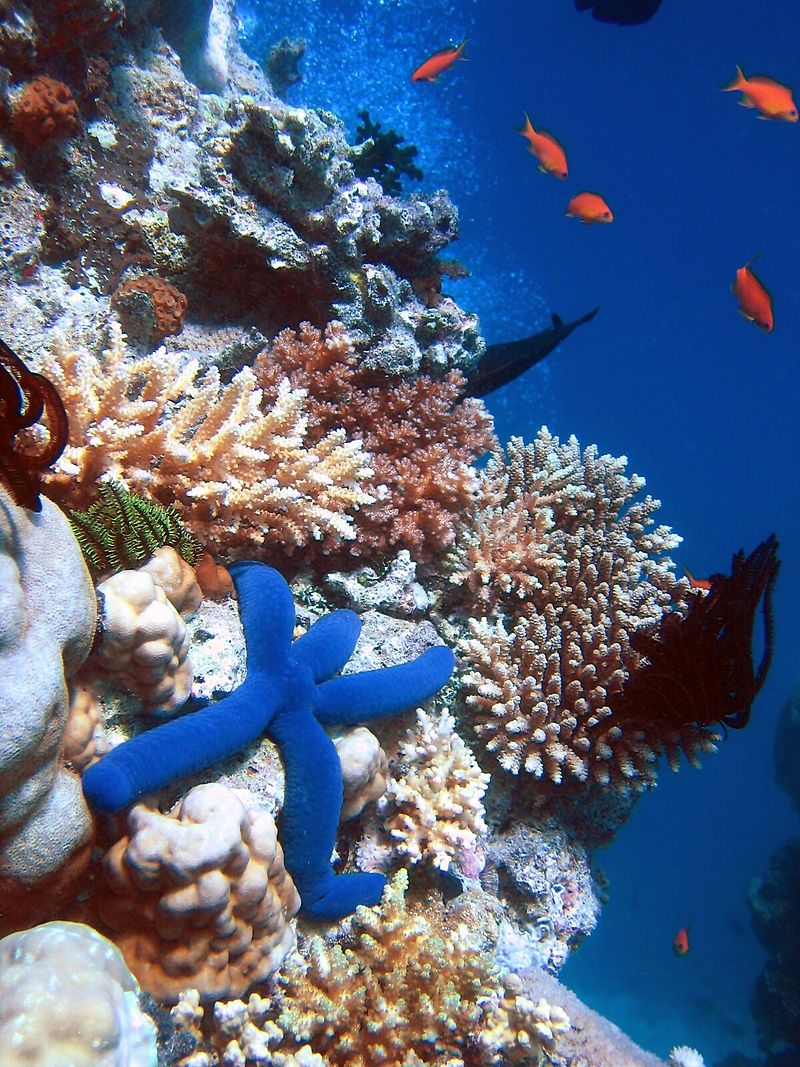
Biodiversity of a coral reef
- Littoral zone
- Intertidal zone
- Estuaries
- Kelp forests
- Coral reefs
- Ocean banks
- Continental shelf
- Neritic zone
- Straits
- Pelagic zone
- Oceanic zone
- Seamounts
- Hydrothermal vents
- Cold seeps
- Demersal zone
- Benthic zone
Formation
Most coral reefs were formed after the last glacial period when melting ice caused sea level to rise and flood continental shelves. Most coral reefs are less than 10,000 years old. As communities established themselves, the reefs grew upwards, pacing rising sea levels. Reefs that rose too slowly could become drowned, without sufficient light.[14] Coral reefs are found in the deep sea away from continental shelves, around oceanic islands and atolls. The majority of these islands are volcanic in origin. Others have tectonic origins where plate movements lifted the deep ocean floor.In The Structure and Distribution of Coral Reefs,[15] Charles Darwin set out his theory of the formation of atoll reefs, an idea he conceived during the voyage of the Beagle. He theorized that uplift and subsidence of the Earth's crust under the oceans formed the atolls.[16] Darwin set out a sequence of three stages in atoll formation. A fringing reef forms around an extinct volcanic island as the island and ocean floor subsides. As the subsidence continues, the fringing reef becomes a barrier reef and ultimately an atoll reef.
- Darwin's theory starts with a volcanic island which becomes extinct
- As the island and ocean floor subside, coral growth builds a fringing reef, often including a shallow lagoon between the land and the main reef.
- As the subsidence continues, the fringing reef becomes a larger barrier reef further from the shore with a bigger and deeper lagoon inside.
- Ultimately, the island sinks below the sea, and the barrier reef becomes an atoll enclosing an open lagoon.
A fringing reef can take ten thousand years to form, and an atoll can take up to 30 million years.[17]
The two main variables determining the geomorphology, or shape, of coral reefs are the nature of the substrate on which they rest, and the history of the change in sea level relative to that substrate.
The approximately 20,000-year-old Great Barrier Reef offers an example of how coral reefs formed on continental shelves. Sea level was then 120 m (390 ft) lower than in the 21st century.[20][21] As sea level rose, the water and the corals encroached on what had been hills of the Australian coastal plain. By 13,000 years ago, sea level had risen to 60 m (200 ft) lower than at present, and many hills of the coastal plains had become continental islands. As sea level rise continued, water topped most of the continental islands. The corals could then overgrow the hills, forming cays and reefs. Sea level on the Great Barrier Reef has not changed significantly in the last 6,000 years.[21] The age of living reef structure is estimated to be between 6,000 and 8,000 years.[22] Although the Great Barrier Reef formed along a continental shelf, and not around a volcanic island, Darwin's principles apply. Development stopped at the barrier reef stage, since Australia is not about to submerge. It formed the world's largest barrier reef, 300–1,000 m (980–3,280 ft) from shore, stretching for 2,000 km (1,200 mi).[23]
Healthy tropical coral reefs grow horizontally from 1 to 3 cm (0.39 to 1.18 in) per year, and grow vertically anywhere from 1 to 25 cm (0.39 to 9.84 in) per year; however, they grow only at depths shallower than 150 m (490 ft) because of their need for sunlight, and cannot grow above sea level.[24]
Material
As the name implies, coral reefs are made up of coral skeletons from mostly intact coral colonies. As other chemical elements present in corals become incorporated into the calcium carbonate deposits, aragonite is formed. However, shell fragments and the remains of coralline algae such as the green-segmented genus Halimeda can add to the reef's ability to withstand damage from storms and other threats. Such mixtures are visible in structures such as Eniwetok Atoll.[25]Types
Since Darwin's identification of the three classical reef formations – the fringing reef around a volcanic island becoming a barrier reef and then an atoll[26] – scientists have identified further reef types. While some sources find only three,[27][28] Thomas and Goudie list four "principal large-scale coral reef types" – the fringing reef, barrier reef, atoll and table reef[29] – while Spalding et al. list five "main types" – the fringing reef, barrier reef, atoll, "bank or platform reef" and patch reef.[30]Fringing reef
Fringing reef
Barrier reef
Barrier reef
The best known and largest example of a barrier reef is the Australian Great Barrier Reef.[33][38] Other major examples are the Belize Barrier Reef and the New Caledonian Barrier Reef.[38] Barrier reefs are also found on the coasts of Providencia,[38] Mayotte, the Gambier Islands, on the southeast coast of Kalimantan, on parts of the coast of Sulawesi, southeastern New Guinea and the south coast of the Louisiade Archipelago.
Platform reef
Platform reef
Platform reefs can be found within atolls. There they are called patch reefs and may reach only a few dozen metres in diameter. Where platform reefs form on an elongated structure, e. g. an old, eroded barrier reef, they can form a linear arrangement. This is the case, for example, on the east coast of the Red Sea near Jeddah. In old platform reefs, the inner part can be so heavily eroded that it forms a pseudo-atoll.[39] These can be distinguished from real atolls only by detailed investigation, possibly including core drilling. Some platform reefs of the Laccadives are U-shaped, due to wind and water flow.
Atoll
Formation of an atoll according to Charles Darwin
Atolls are found in the Indian Ocean, for example, in the Maldives, the Chagos Islands, the Seychelles and around Cocos Island.[38] The entire Maldives consist of 26 atolls.[43]
Other reef types or variants
- Apron reef – short reef resembling a fringing reef, but more sloped; extending out and downward from a point or peninsular shore. The initial stage of a fringing reef.[31]
- Bank reef – isolated, flat-topped reef larger than a patch reef and usually on mid-shelf regions and linear or semi-circular in shape; a type of platform reef.[38]
- Patch reef – common, isolated, comparatively small reef outcrop, usually within a lagoon or embayment, often circular and surrounded by sand or seagrass. Can be considered as a type of platform reef[who?] or as features of fringing reefs, atolls and barrier reefs.[38] The patches may be surrounded by a ring of reduced seagrass cover referred to as a grazing halo.[44]
- Ribbon reef – long, narrow, possibly winding reef, usually associated with an atoll lagoon. Also called a shelf-edge reef or sill reef.[31]
- Habili – reef specific to the Red Sea; does not reach near enough to the surface to cause visible surf; may be a hazard to ships (from the Arabic for "unborn")
- Microatoll – community of species of corals; vertical growth limited by average tidal height; growth morphologies offer a low-resolution record of patterns of sea level change; fossilized remains can be dated using radioactive carbon dating and have been used to reconstruct Holocene sea levels[45]
- Cays – small, low-elevation, sandy islands formed on the surface of coral reefs from eroded material that piles up, forming an area above sea level; can be stabilized by plants to become habitable; occur in tropical environments throughout the Pacific, Atlantic and Indian Oceans (including the Caribbean and on the Great Barrier Reef and Belize Barrier Reef), where they provide habitable and agricultural land
- Seamount or guyot – formed when a coral reef on a volcanic island subsides; tops of seamounts are rounded and guyots are flat; flat tops of guyots, or tablemounts, are due to erosion by waves, winds, and atmospheric processes
Zones
The three major zones of a coral reef: the fore reef, reef crest, and the back reef
The three zones are physically and ecologically interconnected. Reef life and oceanic processes create opportunities for exchange of seawater, sediments, nutrients and marine life.
Most coral reefs exist in waters less than 50 m deep. Some inhabit tropical continental shelves where cool, nutrient-rich upwelling does not occur, such as the Great Barrier Reef. Others are found in the deep ocean surrounding islands or as atolls, such as in the Maldives. The reefs surrounding islands form when islands subside into the ocean, and atolls form when an island subsides below the surface of the sea.
Alternatively, Moyle and Cech distinguish six zones, though most reefs possess only some of the zones.[46]
Water in the reef surface zone is often agitated. This diagram represents a reef on a continental shelf. The water waves at the left travel over the off-reef floor until they encounter the reef slope or fore reef. Then the waves pass over the shallow reef crest. When a wave enters shallow water it shoals, that is, it slows down and the wave height increases.
The off-reef floor is the shallow sea floor surrounding a reef. This zone occurs next to reefs on continental shelves. Reefs around tropical islands and atolls drop abruptly to great depths, and do not have such a floor. Usually sandy, the floor often supports seagrass meadows which are important foraging areas for reef fish.
The reef drop-off is, for its first 50 m, habitat for reef fish who find shelter on the cliff face and plankton in the water nearby. The drop-off zone applies mainly to the reefs surrounding oceanic islands and atolls.
The reef face is the zone above the reef floor or the reef drop-off. This zone is often the reef's most diverse area. Coral and calcareous algae provide complex habitats and areas that offer protection, such as cracks and crevices. Invertebrates and epiphytic algae provide much of the food for other organisms.[46] A common feature on this forereef zone is spur and groove formations that serve to transport sediment downslope.
The reef flat is the sandy-bottomed flat, which can be behind the main reef, containing chunks of coral. This zone may border a lagoon and serve as a protective area, or it may lie between the reef and the shore, and in this case is a flat, rocky area. Fish tend to prefer it when it is present.[46]
The reef lagoon is an entirely enclosed region, which creates an area less affected by wave action and often contains small reef patches.[46]
However, the "topography of coral reefs is constantly changing. Each reef is made up of irregular patches of algae, sessile invertebrates, and bare rock and sand. The size, shape and relative abundance of these patches changes from year to year in response to the various factors that favor one type of patch over another. Growing coral, for example, produces constant change in the fine structure of reefs. On a larger scale, tropical storms may knock out large sections of reef and cause boulders on sandy areas to move."[47]
Locations
Locations of coral reefs
Boundary for 20 °C isotherms.
Most corals live within this boundary. Note the cooler waters caused by
upwelling on the southwest coast of Africa and off the coast of Peru.
This map shows areas of upwelling in red. Coral reefs are not found in coastal areas where colder and nutrient-rich upwellings occur.
Although corals exist both in temperate and tropical waters, shallow-water reefs form only in a zone extending from approximately 30° N to 30° S of the equator. Tropical corals do not grow at depths of over 50 meters (160 ft). The optimum temperature for most coral reefs is 26–27 °C (79–81 °F), and few reefs exist in waters below 18 °C (64 °F).[49] However, reefs in the Persian Gulf have adapted to temperatures of 13 °C (55 °F) in winter and 38 °C (100 °F) in summer.[50] 37 species of scleractinian corals inhabit such an environment around Larak Island.[51]
Deep-water coral inhabits greater depths and colder temperatures at much higher latitudes, as far north as Norway.[52] Although deep water corals can form reefs, little is known about them.
Coral reefs are rare along the west coasts of the Americas and Africa, due primarily to upwelling and strong cold coastal currents that reduce water temperatures in these areas (the Peru, Benguela and Canary Currents respectively).[53] Corals are seldom found along the coastline of South Asia—from the eastern tip of India (Chennai) to the Bangladesh and Myanmar borders[3]—as well as along the coasts of northeastern South America and Bangladesh, due to the freshwater release from the Amazon and Ganges Rivers respectively.
- The Great Barrier Reef—largest, comprising over 2,900 individual reefs and 900 islands stretching for over 2,600 kilometers (1,600 mi) off Queensland, Australia
- The Mesoamerican Barrier Reef System—second largest, stretching 1,000 kilometers (620 mi) from Isla Contoy at the tip of the Yucatán Peninsula down to the Bay Islands of Honduras
- The New Caledonia Barrier Reef—second longest double barrier reef, covering 1,500 kilometers (930 mi)
- The Andros, Bahamas Barrier Reef—third largest, following the east coast of Andros Island, Bahamas, between Andros and Nassau
- The Red Sea—includes 6,000-year-old fringing reefs located along a 2,000 km (1,240 mi) coastline
- The Florida Reef Tract—largest continental US reef and the third largest coral barrier reef, extends from Soldier Key, located in Biscayne Bay, to the Dry Tortugas in the Gulf of Mexico[54]
- Pulley Ridge—deepest photosynthetic coral reef, Florida
- Numerous reefs around the Maldives
- The Philippines coral reef area, the second largest in Southeast Asia, is estimated at 26,000 square kilometers. 915 reef fish species and more than 400 scleractinian coral species, 12 of which are endemic are found there.
- The Raja Ampat Islands in Indonesia's West Papua province offer the highest known marine diversity.[55]
- Bermuda is known for its northernmost coral reef system, located at 32.4°N 64.8°W. The presence of coral reefs at this high latitude is due to the proximity of the Gulf Stream. Bermuda coral species represent a subset of those found in the greater Caribbean.[56]
- The world's northernmost individual coral reef is located within a bay of Japan's Tsushima Island in the Korea Strait.[57]
- The world's southernmost coral reef is at Lord Howe Island, in the Pacific Ocean off the east coast of Australia.
Coral
Close up of polyps arrayed on a coral, waving their tentacles. There can be thousands of polyps on a single coral branch.
Reef-building or hermatypic corals live only in the photic zone (above 50 m), the depth to which sufficient sunlight penetrates the water.
Zooxanthellae
Coral polyps do not photosynthesize, but have a symbiotic relationship with microscopic algae (dinoflagellates) of the genus Symbiodinium, commonly referred to as zooxanthellae. These organisms live within the polyps' tissues and provide organic nutrients that nourish the polyp in the form of glucose, glycerol and amino acids.[59] Because of this relationship, coral reefs grow much faster in clear water, which admits more sunlight. Without their symbionts, coral growth would be too slow to form significant reef structures. Corals get up to 90% of their nutrients from their symbionts.[60] In return, as an example of mutualism, the corals shelter the zooxanthellae, averaging one million for every cubic centimeter of coral, and provide a constant supply of the carbon dioxide they need for photosynthesis.The varying pigments in different species of zooxanthellae give them an overall brown or golden-brown appearance, and give brown corals their colors. Other pigments such as reds, blues, greens, etc. come from colored proteins made by the coral animals. Coral that loses a large fraction of its zooxanthellae becomes white (or sometimes pastel shades in corals that are pigmented with their own proteins) and is said to be bleached, a condition which, unless corrected, can kill the coral.
There are eight clades of Symbiodinium phylotypes. Most research has been conducted on clades A–D. Each clade contributes their own benefits as well as less compatible attributes to the survival of their coral hosts. Each photosynthetic organism has a specific level of sensitivity to photodamage to compounds needed for survival, such as proteins. Rates of regeneration and replication determine the organism's ability to survive. Phylotype A is found more in the shallow waters. It is able to produce mycosporine-like amino acids that are UV resistant, using a derivative of glycerin to absorb the UV radiation and allowing them to better adapt to warmer water temperatures. In the event of UV or thermal damage, if and when repair occurs, it will increase the likelihood of survival of the host and symbiont. This leads to the idea that, evolutionarily, clade A is more UV resistant and thermally resistant than the other clades.[61]
Clades B and C are found more frequently in deeper water, which may explain their higher vulnerability to increased temperatures. Terrestrial plants that receive less sunlight because they are found in the undergrowth are analogous to clades B, C, and D. Since clades B through D are found at deeper depths, they require an elevated light absorption rate to be able to synthesize as much energy. With elevated absorption rates at UV wavelengths, these phylotypes are more prone to coral bleaching versus the shallow clade A.
Clade D has been observed to be high temperature-tolerant, and has a higher rate of survival than clades B and C during modern bleaching events.[61]
Skeleton
Reefs grow as polyps and other organisms deposit calcium carbonate,[62][63] the basis of coral, as a skeletal structure beneath and around themselves, pushing the coral head's top upwards and outwards.[64] Waves, grazing fish (such as parrotfish), sea urchins, sponges and other forces and organisms act as bioeroders, breaking down coral skeletons into fragments that settle into spaces in the reef structure or form sandy bottoms in associated reef lagoons.Typical shapes for coral species are named by their resemblance to terrestrial objects such as wrinkled brains, cabbages, table tops, antlers, wire strands and pillars. These shapes can depend on the life history of the coral, like light exposure and wave action,[65] and events such as breakages.[66]
Reproduction
Corals reproduce both sexually and asexually. An individual polyp uses both reproductive modes within its lifetime. Corals reproduce sexually by either internal or external fertilization. The reproductive cells are found on the mesenteries, membranes that radiate inward from the layer of tissue that lines the stomach cavity. Some mature adult corals are hermaphroditic; others are exclusively male or female. A few species change sex as they grow.Internally fertilized eggs develop in the polyp for a period ranging from days to weeks. Subsequent development produces a tiny larva, known as a planula. Externally fertilized eggs develop during synchronized spawning. Polyps across a reef simultaneously release eggs and sperm into the water en masse. Spawn disperse over a large area. The timing of spawning depends on time of year, water temperature, and tidal and lunar cycles. Spawning is most successful given little variation between high and low tide. The less water movement, the better the chance for fertilization. Ideal timing occurs in the spring. Release of eggs or planula usually occurs at night, and is sometimes in phase with the lunar cycle (three to six days after a full moon). The period from release to settlement lasts only a few days, but some planulae can survive afloat for several weeks. They are vulnerable to predation and environmental conditions. The lucky few planulae that successfully attach to substrate then compete for food and space.[citation needed]
Other reef builders
Corals are the most prodigious reef-builders. However many other organisms living in the reef community contribute skeletal calcium carbonate in the same manner as corals. These include coralline algae and some sponges.[67] Reefs are always built by the combined efforts of these different phyla, with different organisms leading reef-building in different geological periods.[citation needed]Coralline algae
Corraline algae Lithothamnion sp.
Sponges
Deep-water cloud sponge
In the northern Pacific Ocean cloud sponges still create deep-water mineral-structures without corals, although the structures are not recognizable from the surface like tropical reefs. They are the only extant organisms known to build reef-like structures in cold water.[citation needed]
Gallery of reef-building corals and their reef-building assistants
- Fluorescent coral[68]
- Corraline algae Mesophyllum sp.
- coralline algae Corallina officinalis
Darwin's paradox
— Francis Rougerie[69]
Tropical waters contain few nutrients[71] yet a coral reef can flourish like an "oasis in the desert".[72] This has given rise to the ecosystem conundrum, sometimes called "Darwin's paradox": "How can such high production flourish in such nutrient poor conditions?"[73][74][75]
Coral reefs support over one-quarter of all marine species. This diversity results in complex food webs, with large predator fish eating smaller forage fish that eat yet smaller zooplankton and so on. However, all food webs eventually depend on plants, which are the primary producers. Coral reefs typically produce 5–10 grams of carbon per square meter per day (gC·m−2·day−1) biomass.[76][77]
One reason for the unusual clarity of tropical waters is their nutrient deficiency and drifting plankton. Further, the sun shines year-round in the tropics, warming the surface layer, making it less dense than subsurface layers. The warmer water is separated from deeper, cooler water by a stable thermocline, where the temperature makes a rapid change. This keeps the warm surface waters floating above the cooler deeper waters. In most parts of the ocean, there is little exchange between these layers. Organisms that die in aquatic environments generally sink to the bottom, where they decompose, which releases nutrients in the form of nitrogen (N), phosphorus (P) and potassium (K). These nutrients are necessary for plant growth, but in the tropics, they do not directly return to the surface.[citation needed]
Plants form the base of the food chain and need sunlight and nutrients to grow. In the ocean, these plants are mainly microscopic phytoplankton which drift in the water column. They need sunlight for photosynthesis, which powers carbon fixation, so they are found only relatively near the surface, but they also need nutrients. Phytoplankton rapidly use nutrients in the surface waters, and in the tropics, these nutrients are not usually replaced because of the thermocline.[citation needed]
Coral polyps
Explanations
Around coral reefs, lagoons fill in with material eroded from the reef and the island. They become havens for marine life, providing protection from waves and storms.Most importantly, reefs recycle nutrients, which happens much less in the open ocean. In coral reefs and lagoons, producers include phytoplankton, as well as seaweed and coralline algae, especially small types called turf algae, which pass nutrients to corals.[78] The phytoplankton form the base of the food chain and are eaten by fish and crustaceans. Recycling reduces the nutrient inputs needed overall to support the community.[60]
The color of corals depends on the combination of brown shades provided by their zooxanthellae and pigmented proteins (reds, blues, greens, etc.) produced by the corals themselves.
Sponges live in crevices in the reefs. They are efficient filter feeders, and in the Red Sea they consume about 60% of the phytoplankton that drifts by. Sponges eventually excrete nutrients in a form that corals can use.[79]
Most coral polyps are nocturnal feeders. Here, in the dark, polyps have extended their tentacles to feed on zooplankton.
Deep nutrient-rich water entering coral reefs through isolated events may have significant effects on temperature and nutrient systems.[81][82] This water movement disrupts the relatively stable thermocline that usually exists between warm shallow water and deeper colder water. Temperature regimes on coral reefs in the Bahamas and Florida are highly variable with temporal scales of minutes to seasons and spatial scales across depths.[83]
Water can pass through coral reefs in various ways, including current rings, surface waves, internal waves and tidal changes.[81][84][85][86] Movement is generally created by tides and wind. As tides interact with varying bathymetry and wind mixes with surface water, internal waves are created. An internal wave is a gravity wave that moves along density stratification within the ocean. When a water parcel encounters a different density it oscillates and creates internal waves.[87] While internal waves generally have a lower frequency than surface waves, they often form as a single wave that breaks into multiple waves as it hits a slope and moves upward.[88] This vertical breakup of internal waves causes significant diapycnal mixing and turbulence.[89][90] Internal waves can act as nutrient pumps, bringing plankton and cool nutrient-rich water to the surface.[81][86][91][92][93][94][95][96][97][98][99]
The irregular structure characteristic of coral reef bathymetry may enhance mixing and produce pockets of cooler water and variable nutrient content.[100] Arrival of cool, nutrient-rich water from depths due to internal waves and tidal bores has been linked to growth rates of suspension feeders and benthic algae[86][99][101] as well as plankton and larval organisms.[86][102] The seaweed Codium isthmocladum reacts to deep water nutrient sources because their tissues have different concentrations of nutrients dependent upon depth.[99] Aggregations of eggs, larval organisms and plankton on reefs respond to deep water intrusions.[93] Similarly, as internal waves and bores move vertically, surface-dwelling larval organisms are carried toward the shore.[102] This has significant biological importance to cascading effects of food chains in coral reef ecosystems and may provide yet another key to unlocking the paradox.
Cyanobacteria provide soluble nitrates via nitrogen fixation.[103]
Coral reefs often depend on surrounding habitats, such as seagrass meadows and mangrove forests, for nutrients. Seagrass and mangroves supply dead plants and animals that are rich in nitrogen and serve to feed fish and animals from the reef by supplying wood and vegetation. Reefs, in turn, protect mangroves and seagrass from waves and produce sediment in which the mangroves and seagrass can root.[50]
Biodiversity
Reefs are home to a variety of animals, including fish, seabirds, sponges, cnidarians (which includes some types of corals and jellyfish), worms, crustaceans (including shrimp, cleaner shrimp, spiny lobsters and crabs), mollusks (including cephalopods), echinoderms (including starfish, sea urchins and sea cucumbers), sea squirts, sea turtles and sea snakes. Aside from humans, mammals are rare on coral reefs, with visiting cetaceans such as dolphins the main exception. A few species feed directly on corals, while others graze on algae on the reef.[3][78] Reef biomass is positively related to species diversity.[107]
The same hideouts in a reef may be regularly inhabited by different species at different times of day. Nighttime predators such as cardinalfish and squirrelfish hide during the day, while damselfish, surgeonfish, triggerfish, wrasses and parrotfish hide from eels and sharks.[25]:49
The great number and diversity of hiding places in coral reefs, i.e. refuges, are the most important factor causing the great diversity and high biomass of the organisms in coral reefs.[108][109]
Algae
Reefs are chronically at risk of algal encroachment. Overfishing and excess nutrient supply from onshore can enable algae to outcompete and kill the coral.[110][111] Increased nutrient levels can be a result of sewage or chemical fertilizer runoff. Runoff can carry nitrogen and phosphorus which promote excess algae growth. Algae can sometimes out-compete the coral for space. The algae can then smother the coral by decreasing the oxygen supply available to the reef.[112] Decreased oxygen levels can slow down calcification rates, weakening the coral and leaving it more susceptible to disease and degradation.[113] Algae inhabit a large percentage of surveyed coral locations.[114] The algal population consists of turf algae, coralline algae and macro algae. Some sea urchins (such as Diadema antillarum) eat these algae and could thus decrease the risk of algal encroachment.Sponges
Sponges are essential for the functioning of the coral reef that system. Algae and corals in coral reefs produce organic material. This is filtered through sponges which convert this organic material into small particles which in turn are absorbed by algae and corals.[115]Fish
Over 4,000 species of fish inhabit coral reefs.[3] The reasons for this diversity remain unclear. Hypotheses include the "lottery", in which the first (lucky winner) recruit to a territory is typically able to defend it against latecomers, "competition", in which adults compete for territory, and less-competitive species must be able to survive in poorer habitat, and "predation", in which population size is a function of postsettlement piscivore mortality.[116] Healthy reefs can produce up to 35 tons of fish per square kilometer each year, but damaged reefs produce much less.[117]Invertebrates
Sea urchins, Dotidae and sea slugs eat seaweed. Some species of sea urchins, such as Diadema antillarum, can play a pivotal part in preventing algae from overrunning reefs.[118] Researchers are investigating the use of native collector urchins, Tripneustes gratilla, for their potential as biocontrol agents to mitigate the spread of invasive algae species on coral reefs.[119][120] Nudibranchia and sea anemones eat sponges.A number of invertebrates, collectively called "cryptofauna," inhabit the coral skeletal substrate itself, either boring into the skeletons (through the process of bioerosion) or living in pre-existing voids and crevices. Animals boring into the rock include sponges, bivalve mollusks, and sipunculans. Those settling on the reef include many other species, particularly crustaceans and polychaete worms.[53]
Seabirds
Coral reef systems provide important habitats for seabird species, some endangered. For example, Midway Atoll in Hawaii supports nearly three million seabirds, including two-thirds (1.5 million) of the global population of Laysan albatross, and one-third of the global population of black-footed albatross.[121] Each seabird species has specific sites on the atoll where they nest. Altogether, 17 species of seabirds live on Midway. The short-tailed albatross is the rarest, with fewer than 2,200 surviving after excessive feather hunting in the late 19th century.[122]Other
Sea snakes feed exclusively on fish and their eggs.[123][124][125] Marine birds, such as herons, gannets, pelicans and boobies, feed on reef fish. Some land-based reptiles intermittently associate with reefs, such as monitor lizards, the marine crocodile and semiaquatic snakes, such as Laticauda colubrina. Sea turtles, particularly hawksbill sea turtles, feed on sponges.[126][127][128]- The shell of Latiaxis wormaldi, a coral snail
Ecosystem services
Coral reefs deliver ecosystem services to tourism, fisheries and coastline protection. The global economic value of coral reefs has been estimated to be between US$29.8 billion[7] and $375 billion per year.[8]The economic cost over a 25-year period of destroying one kilometer of coral reef has been estimated to be somewhere between $137,000 and $1,200,000.[129]
To improve the management of coastal coral reefs, the World Resources Institute (WRI) developed and published tools for calculating the value of coral reef-related tourism, shoreline protection and fisheries, partnering with five Caribbean countries. As of April 2011, published working papers covered St. Lucia, Tobago, Belize, and the Dominican Republic. The WRI was "making sure that the study results support improved coastal policies and management planning".[130] The Belize study estimated the value of reef and mangrove services at $395–559 million annually.[131]
Bermuda's coral reefs provide economic benefits to the Island worth on average $722 million per year, based on six key ecosystem services, according to Sarkis et al (2010).[132]
Shoreline protection
Coral reefs protect shorelines by absorbing wave energy, and many small islands would not exist without reefs. Coral reefs can reduce wave energy by 97%, helping to prevent loss of life and property damage. Coastlines protected by coral reefs are also more stable in terms of erosion than those without. Reefs can attenuate waves as well as or better than artificial structures designed for coastal defence such as breakwaters.[133] An estimated 197 million people who live both below 10 m elevation and within 50 km of a reef consequently may receive risk reduction benefits from reefs. Restoring reefs is significantly cheaper than building artificial breakwaters in tropical environments. Expected damages from flooding would double, and costs from frequent storms would triple without the topmost meter of reefs. For 100-year storm events, flood damages would increase by 91% to $US 272 billion without the top meter.[134]Fisheries
About six million tons of fish are taken each year from coral reefs. Well-managed reefs have an average annual yield of 15 tons of seafood per square kilometer. Southeast Asia's coral reef fisheries alone yield about $2.4 billion annually from seafood.[129]Threats
This include coral mining, bottom trawling,[139] and the digging of canals and accesses into islands and bays, all of which can damage marine ecosystems if not done sustainably. Other localized threats include blast fishing, overfishing, coral overmining,[140] and marine pollution, including use of the banned anti-fouling biocide tributyltin; although absent in developed countries, these activities continue in places with few environmental protections or poor regulatory enforcement.[141][142][143] Chemicals in sunscreens may awaken latent viral infections in zooxanthellae[10] and impact reproduction.[144] However, concentrating tourism activities via offshore platforms has been shown to limit the spread of coral disease by tourists.[145]
Greenhouse gas emissions present a broader threat through sea temperature rise and sea level rise,[146] though corals adapt their calcifying fluids to changes in seawater pH and carbonate levels and are not directly threatened by ocean acidification.[147] Volcanic and manmade aerosol pollution can modulate regional sea surface temperatures.[148]
In 2011, two researchers suggested that "extant marine invertebrates face the same synergistic effects of multiple stressors" that occurred during the end-Permian extinction, and that genera "with poorly buffered respiratory physiology and calcareous shells", such as corals, were particularly vulnerable.[149][150][151]
A major coral bleaching event took place on this part of the Great Barrier Reef in Australia
Every 4–7 years, an El Niño event causes some reefs with heat-sensitive corals to bleach,[154] with especially widespread bleachings in 1998 and 2010.[155][156] However, reefs that experience a severe bleaching event become resistant to future heat-induced bleaching,[157][158][153] due to rapid directional selection.[158] Similar rapid adaption may protect coral reefs from global warming.[159]
A large-scale systematic study of the Jarvis Island coral community, which experienced ten El Niño-coincident coral bleaching events from 1960 to 2016, found that the reef recovered from almost complete death after severe events.[154]
Protection
A diversity of corals
However, research in Indonesia, Philippines and Papua New Guinea found no significant difference between an MPA site and an unprotected site.[160][161] Further, they can generate conflicts driven by lack of community participation, clashing views of the government and fisheries, effectiveness of the area and funding.[162] In some situations, as in the Phoenix Islands Protected Area, MPAs provide revenue, potentially equal to the income they would have generated without controls.[163]
According to the Caribbean Coral Reefs - Status Report 19702-2012, states that; stop overfishing especially fishes key to coral reef like parrotfish, coastal zone management that reduce human pressure on reef, (for example restricting coastal settlement, development and tourism) and control pollution specially sewage, may reduce coral decline or even reverse it. The report shows that healthier reefs in the Caribbean are those with large populations of parrotfish in countries that protect these key fishes and sea urchins, banning fish trapping and spearfishing, creating "resilient reefs".[164][165]
To help combat ocean acidification, some laws are in place to reduce greenhouse gases such as carbon dioxide. The United States Clean Water Act puts pressure on state governments to monitor and limit runoff.
Many land use laws aim to reduce CO2 emissions by limiting deforestation. Deforestation can release significant amounts of CO2 absent sequestration via active follow-up forestry programs. Deforestation can also cause erosion, which flows into the ocean, contributing to ocean acidification. Incentives are used to reduce miles traveled by vehicles, which reduces carbon emissions into the atmosphere, thereby reducing the amount of dissolved CO2 in the ocean. State and federal governments also regulate land activities that affect coastal erosion.[166] High-end satellite technology can monitor reef conditions.[167]
Designating a reef as a biosphere reserve, marine park, national monument or world heritage site can offer protections. For example, Belize's barrier reef, Sian Ka'an, the Galapagos islands, Great Barrier Reef, Henderson Island, Palau and Papahānaumokuākea Marine National Monument are world heritage sites.[168]
In Australia, the Great Barrier Reef is protected by the Great Barrier Reef Marine Park Authority, and is the subject of much legislation, including a biodiversity action plan.[169] Australia compiled a Coral Reef Resilience Action Plan. This plan consists of adaptive management strategies, including reducing carbon footprint. A public awareness plan providezs education on the "rainforests of the sea" and how people can reduce carbon emissions.[170]
Inhabitants of Ahus Island, Manus Province, Papua New Guinea, have followed a generations-old practice of restricting fishing in six areas of their reef lagoon. Their cultural traditions allow line fishing, but no net or spear fishing. Both biomass and individual fish sizes are significantly larger than in places where fishing is unrestricted.[171][172]
Restoration
Coral fragments growing on nontoxic concrete
Coral farming
Coral aquaculture, also known as coral farming or coral gardening, is showing promise as a potentially effective tool for restoring coral reefs.[173][174][175]The "gardening" process bypasses the early growth stages of corals when they are most at risk of dying. Coral seeds are grown in nurseries, then replanted on the reef.[176] Coral is farmed by coral farmers whose interests range from reef conservation to increased income.
Creating substrate
Efforts to expand the size and number of coral reefs generally involve supplying substrate to allow more corals to find a home. Substrate materials include discarded vehicle tires, scuttled ships, subway cars and formed concrete, such as reef balls. Reefs grow unaided on marine structures such as oil rigs.[177] In large restoration projects, propagated hermatypic coral on substrate can be secured with metal pins, superglue or milliput.[178] Needle and thread can also attach A-hermatype coral to substrate.[179]Biorock is a substrate produced by a patented process[180] that runs low voltage electrical currents through seawater to cause dissolved minerals to precipitate onto steel structures. The resultant white carbonate (aragonite) is the same mineral that makes up natural coral reefs. Corals rapidly colonize and grow at accelerated rates on these coated structures. The electrical currents also accelerate formation and growth of both chemical limestone rock and the skeletons of corals and other shell-bearing organisms, such as oysters. The vicinity of the anode and cathode provides a high-pH environment which inhibits the growth of competitive filamentous and fleshy algae. The increased growth rates fully depend on the accretion activity.[181]
Under the influence of the electric field, corals display an increased growth rate, size and density.[181]
Relocation
One case study with coral reef restoration was conducted on the island of Oahu in Hawaii. The University of Hawaii operates a Coral Reef Assessment and Monitoring Program to help relocate and restore coral reefs in Hawaii. A boat channel from the island of Oahu to the Hawaii Institute of Marine Biology on Coconut Island was overcrowded with coral reefs. Many areas of coral reef patches in the channel had been damaged from past dredging in the channel.Dredging covers corals with sand. Coral larvae cannot settle on sand; they can only build on existing reefs or compatible hard surfaces, such as rock or concrete. Because of this, the University decided to relocate some of the coral. They transplanted them with the help of United States Army divers, to a site relatively close to the channel. They observed little if any damage to any of the colonies during transport and no mortality of coral reefs was observed on the transplant site. While attaching the coral to the transplant site, they found that coral placed on hard rock grew well, including on the wires that attached the corals to the site.
No environmental effects were seen from the transplantation process, recreational activities were not decreased, and no scenic areas were affected.[182]
As an alternative to transplanting coral themselves, juvenile fish can also be encouraged to relocate to existing coral reefs by auditory simulation. In damaged sections of the Great Barrier Reef, loudspeakers playing recordings of healthy reef environments, were found to attract fish twice as often as equivalent patches where no sound was played, and also increased species biodiversity by 50%.[183]
Heat-tolerant symbionts
Another possibility for coral restoration is gene therapy: inoculating coral with genetically modified bacteria, or naturally-occurring heat-tolerant varieties of coral symbiotes, may make it possible to grow corals that are more resistant to climate change and other threats.[184]Invasive algae
Hawaiian coral reefs smothered by the spread of invasive algae were managed with a two-prong approach: divers manually removed invasive algae, with the support of super-sucker barges. Grazing pressure on invasive algae needed to be increased to prevent the regrowth of the algae.Researchers found that native collector urchins were reasonable candidate grazers for algae biocontrol, to extirpate the remaining invasive algae from the reef.[119]
Microfragmentation and Fusion
In 2014, Christopher Page, Erinn Muller, and David Vaughan from the International Center for Coral Reef Research & Restoration at Mote Marine Laboratory in Summerland Key, Florida developed a new technology called "microfragmentation," in which they use a specialized diamond band saw to cut corals into 1 cm2 fragments instead of 3 cm2 to advance the growth of brain, boulder, and star corals.[185] They found that microfragments grow at a rate four times that of the larger fragments and in just a few weeks a few polyps could grow into the size of a large coin, which previously took three years to develop.[186] By using this method, Mote Marine Laboratory produced 25,000 corals and planted 10,000 in the Florida Keys in only one year. Shortly after, they discovered that these microfragments fused with other microfragments as long as they came from the same parent coral.[187] Whereas corals not related genetically typically fight and kill nearby corals in an attempt to survive, microfragments did not demonstrate this behavior. This new technology is known as "fusion" and has been shown to grow coral heads in just two years instead of the typical 25–75 years.[188]History
Ancient coral reefs
Not all reefs in the past were formed by corals: those in the Early Cambrian (542–513 Ma) resulted from calcareous algae and archaeocyathids (small animals with conical shape, probably related to sponges) and in the Late Cretaceous (100–66 Ma), when reefs formed by a group of bivalves called rudists existed; one of the valves formed the main conical structure and the other, much smaller valve acted as a cap.
Measurements of the oxygen isotopic composition of the aragonitic skeleton of coral reefs, such as Porites, can indicate changes in sea surface temperature and sea surface salinity conditions during the growth of the coral. This technique is often used by climate scientists to infer a region's paleoclimate.[189]


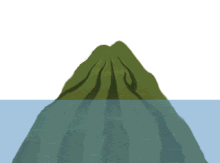

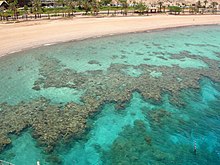
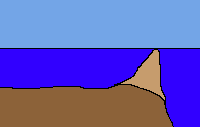

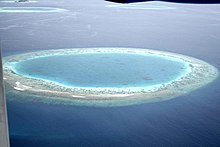
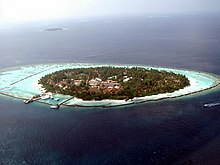


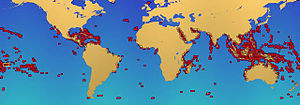
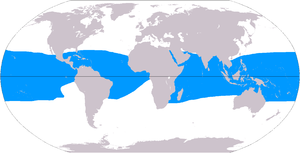
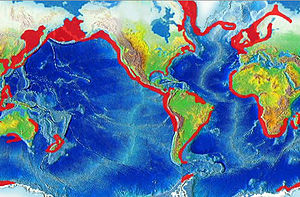

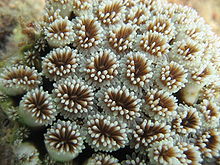
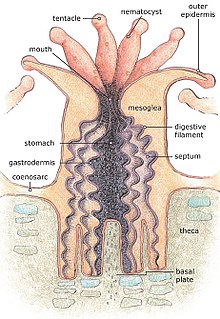
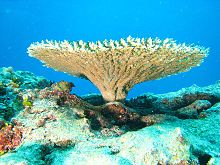



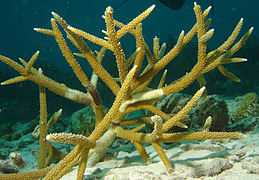





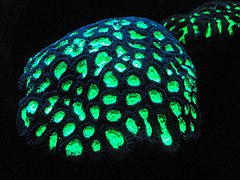




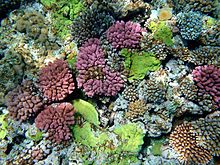
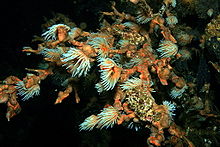


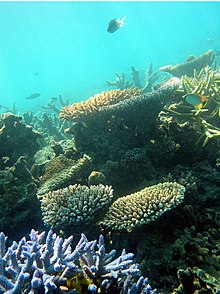



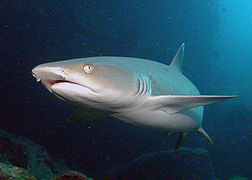



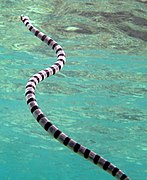

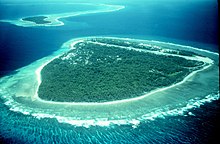
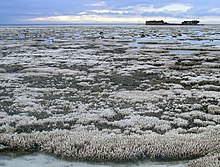

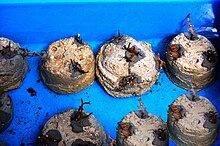
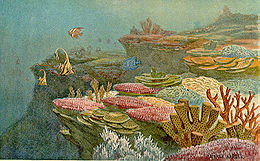
No comments:
Post a Comment
Note: Only a member of this blog may post a comment.